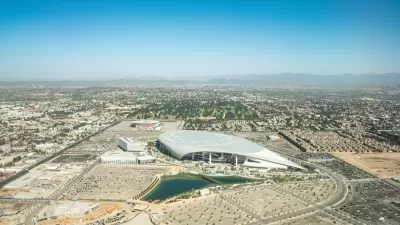The new home of the Los Angeles Rams and the Los Angeles Charger is almost ready for prime time. The mayor's economic development dreams are on the line as much as any championship.

Jason Henry reports from Inglewood, California, where the city surrounded by Los Angeles, LAX, and the South Bay cities is expecting a transformation when a new NFL stadium opens nest year.
Mayor James Butts makes a comparison to Star Trek when describing the expected effect of the stadium,, which represents a $5 billion investment at the former site of the race track, Hollywood Park.
First there's the change on the redevelopment site itself:
Although the newly branded SoFi Stadium will open in the summer of 2020 as the home of the Los Angeles Rams and Chargers, construction will continue for years after the first kickoff. In phases, the Hollywood Park site — 3 1/2 times the acreage of Disneyland — will gain apartments, four public parks, a 300-room hotel and new retail spaces, including a spot for Inglewood beer maker Three Weavers Brewing.
But Mayor Butts is also hopping for a catalytic effect in the surrounding neighborhood and the rest of the city, too. One major nearby development plan is already on its way toward construction, and another is still in planning stages, according to Henry:
Across the street, developer Izek Shomof is renovating former Airport Park View into a high-end, 180-room hotel with a design that fits in with the nearby casino. If the Los Angeles Clippers build their grand, oval-shaped arena in the lots surrounding the property, the hotel — opening in 2020 — will be perfectly situated for both football and basketball fans.
The article also details some of the changes that will already be apparent to visitors who haven't been to the city since the Lakers and the Kings left for Downtown.
FULL STORY: NFL stadium a catalyst for Inglewood rebirth, but some fear the community is losing its soul

Planetizen Federal Action Tracker
A weekly monitor of how Trump’s orders and actions are impacting planners and planning in America.

Maui's Vacation Rental Debate Turns Ugly
Verbal attacks, misinformation campaigns and fistfights plague a high-stakes debate to convert thousands of vacation rentals into long-term housing.

Restaurant Patios Were a Pandemic Win — Why Were They so Hard to Keep?
Social distancing requirements and changes in travel patterns prompted cities to pilot new uses for street and sidewalk space. Then it got complicated.

In California Battle of Housing vs. Environment, Housing Just Won
A new state law significantly limits the power of CEQA, an environmental review law that served as a powerful tool for blocking new development.

Boulder Eliminates Parking Minimums Citywide
Officials estimate the cost of building a single underground parking space at up to $100,000.

Orange County, Florida Adopts Largest US “Sprawl Repair” Code
The ‘Orange Code’ seeks to rectify decades of sprawl-inducing, car-oriented development.
Urban Design for Planners 1: Software Tools
This six-course series explores essential urban design concepts using open source software and equips planners with the tools they need to participate fully in the urban design process.
Planning for Universal Design
Learn the tools for implementing Universal Design in planning regulations.
Heyer Gruel & Associates PA
JM Goldson LLC
Custer County Colorado
City of Camden Redevelopment Agency
City of Astoria
Transportation Research & Education Center (TREC) at Portland State University
Jefferson Parish Government
Camden Redevelopment Agency
City of Claremont





























